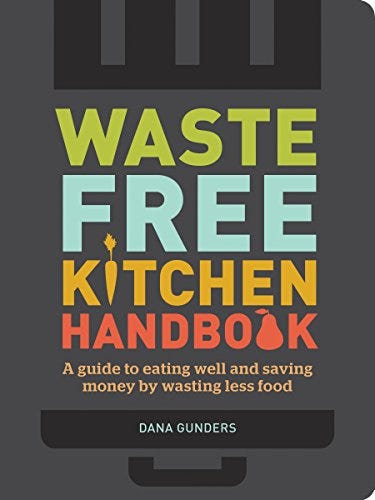There’s nothing quite like the sweet success of a good weekend grocery haul. Just one look at your fully stocked fridge has you patting yourself on the back: a week of fresh and delish dishes comin’ right up. But on Monday that broccoli gets the boot from your fam. Tuesday, you work later than planned, leaving you too tired for that new pesto-chicken recipe. And Wednesday, impromptu dinner plans with friends easily wins over DIY dining. Sound familiar?
Americans throw out more than 400 pounds of food per person annually, according to the Natural Resources Defense Council (NRDC). But it’s not just about the neglected noshes. “When we toss food, we waste natural resources—energy, water, air, soil—all of which are required for production,” says Katherine Miller, vice president of impact at the James Beard Foundation. And, ugh, more cons: Leaving grub to rot in landfills produces the same amount of greenhouse gases as 37 million cars. Whoa. This can also wreak havoc on your wellness. Amped-up emissions make it harder to breathe by aggravating asthma. What’s more, rising temps (courtesy of global warming) can lead to stress, anxiety, and depression and increase your risk for cardiovascular issues such as stroke.
The good news? There are ways to prevent climate change. The even better news? Reducing your food-waste output is an easy place to start, says Miller. It’s totally doable on any diet from allergen-free to keto. So, master these strategies to go green while still eating your greens. PSA: Mother Earth—and your health—will thank you.
1. Focus on Storage

Of course you don’t mean to toss all that food, but truth is, the majority of food waste happens in homes (not restaurants). Here’s step one: Figure out how much you’re wasting. “For one to two weeks, put all the food you’d typically discard into a bin in your fridge or on your counter. Then take stock of what you’ve collected to start making better decisions,” says Emily Broad Leib, director of the Harvard Law School Food Law and Policy Clinic.
Next: Create “eat me first” areas for edibles that need to be used quickly, like berries or dairy products—no shame in labeling as a reminder!—and practice reorganizing your fridge post-shop. As you unpack your bags, move older goods to the front so you grab ’em before recent buys. This will also make it easier to “shop your fridge” later—i.e., see what you still have before heading to the market, says scientist Dana Gunders, formerly of the NRDC and author of Waste-Free Kitchen Handbook.
2. Judge Less, Eat More
We hold our food to impossible standards of perfection, frequently nixing safe and delish eats just because of a scar (which, btw, is usually caused by a nearby tree limb) or an unusual shape. Choose “ugly produce” at the market, which sometimes costs less, and look for companies like Hungry Harvest that focus on imperfect—and otherwise wasted—food. Unless there’s mold, a rancid smell or taste, or, in the case of potatoes, green coloring, the grub is likely still good to go.

If you’re unsure, just remove any deformities or signs of aging, such as browning tips of lettuce and bruising on fruit. Even wilting veggies are okay—you can perk ’em up with a quick ice bath. What about “sell by” or “use by” dates? That’s where things get a little trickier. “Most food labels are just manufacturers’ estimates of shelf life and not based on a safety test,” says Broad Leib. If you’re throwing away anything that’s just expired, chances are it’s safe to eat. Still nervous? Give milk and meat a sniff or check out the USDA’s FoodKeeper app to find out how long different foods typically last.
3. Get Creative
Easier said than done, after all that planning and preparing. But hey, life happens, and before you’re able to chop up those tomatoes, they’ve softened, making them no bueno for a salad. Before chucking, however, remember that cooking can be a great solution for veggies’ texture troubles—and in some cases, leave you with a juicy garnish. “We also need to be more flexible when it comes to using the entire veggie,” says Cannon. “Roasting the stalk and leaves alongside typical cuts of cauliflower is a great way to get more nutrients like fiber.” Your new mantra: Don’t scrap it; try to save it.
Watch Jenna Dewan taste-test this vegan fast food:
4. Plan and Prep
A list can help limit impulse buys, lower your grocery bill, and make fewer shopping trips, according to market research. The secret to creating a winning list (and scoring all these pluses) is meal planning—realistically. That means taking into consideration things like dinner with friends or lazy eves that call for leftovers.
“Try reserving a night, like a Stir Fry-day or a Wasteless Wednesday, when you use up everything that’s left in the kitchen,” suggests Gunders. Simply scheduling for the week ensures you have the ingredients for healthier choices, and lowers the likelihood of
ordering in less-favorable eats.
5. Embrace the Freezer
There’s no denying it: We’re big fans of stuffing a cart with tons of produce. But despite best intentions, fruits and veggies are the number one culprit in daily food waste at home. So if you notice you’re always buying fresh broccoli only to throw it away, opt for frozen. “Plus, these foods are typically flash-frozen at their peak, which locks in the nutrients that are gradually lost the longer an item sits in the market or kitchen,” says Abby K. Cannon, JD, RD, CDN, a dietitian and sustainability expert in New York City.

Another way to save all those nutritional benefits: Freeze them! Using the freezer as short-term storage for everything from milk to last night’s salmon dish (you can even freeze walnuts and almonds) not only cuts back on tossing but also takes the pressure off having to cook and eat ingredients within a certain time, explains Gunders. Package food in small quantities so it freezes faster, which helps maintain flavor and texture.
6. Pickle Almost Anything
Pickling is a savvy way to preserve veggies on the verge of turning for a few more weeks. An easy brine for carrots, green beans, or zucchini? In a small pot, mix 1¼ cups distilled white vinegar, 1 cup water, 4 cloves peeled and crushed garlic, 3 Tbsp sugar, and 2 Tbsp kosher salt. Heat on medium, stirring, until sugar dissolves. Pour this mixture into a 32-oz jar along with 1 lb desired vegetables, quartered lengthwise, and 3 sprigs of dill. Let cool slightly, then replace the lid and refrigerate at least 4 hours or up to 2 weeks.
Source: Read Full Article
